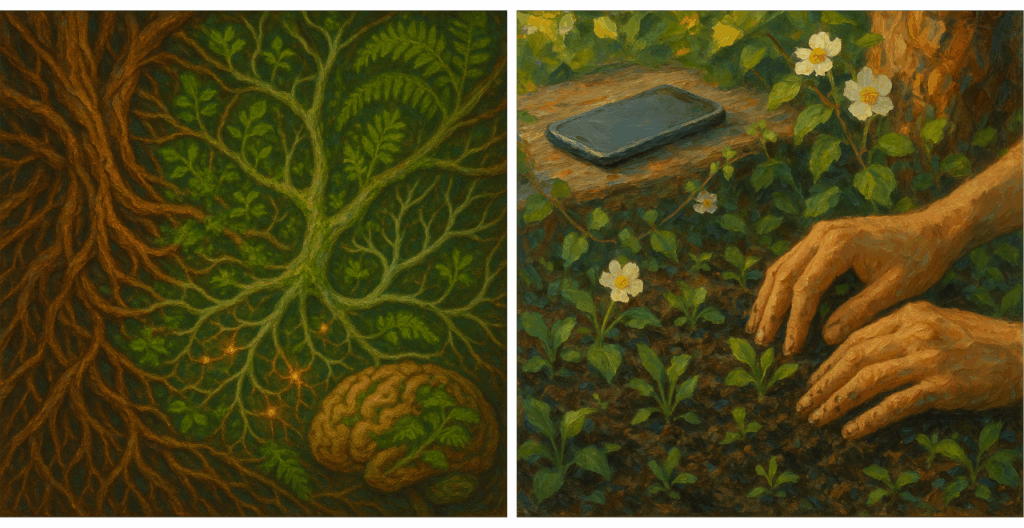
Here’s a scary stat: the average person now logs nearly seven hours of daily screen time, which means you probably spend more time looking at screens than sleeping.
Maybe you’ve tried muting notifications or deleting certain apps, but it’s still hard to escape the constant influx of emails, alerts, and scrolling that drains your focus and creativity.
What if the antidote to digital fatigue isn’t found in better apps or stricter screen limits, but in reclaiming analog experiences?
Why Going Analog Is Good for Your Brain
When you step away from screens, your brain activates what neuroscientists call the default mode network – a system involved in memory consolidation and creative insight. Research shows that this downtime helps you connect ideas, process emotions, and solve problems more effectively.
Other studies confirm that even brief breaks from social media reduce depression and anxiety, while time outdoors improves cerebral blood flow and boosts dopamine and norepinephrine, which are neurotransmitters tied to focus and motivation.
People seem to know this instinctively. There’s been a quiet return to pre-digital activities. Print book sales are rising as readers rediscover the focus that comes from physical pages. Off-the-grid retreats are booming.
Even social life is shifting: phone-free dinners, game nights, and sunday salons are becoming popular ways to connect without distraction. For instance, I recently met someone who opens her apartment every Sunday morning. Friends drop by at different times, some for a quick coffee, others bringing pastries after a run. It’s a simple way to share some analog time.
This shift isn’t about longing for the past. The return to books, in-person gatherings, and offline rituals is happening because people find they think more clearly, rest more deeply, and connect more easily when they do. So, how can you also participate in this analog renaissance?
Making the Most of the Analog Renaissance
Knowing the benefits of time away from screens is one thing, but building them into your daily life is another. It’s not just about having phone-free breaks. It’s about actively engaging with the 3D world and soaking in everything it has to offer. Here are some ideas to get you started:
1. Experiment with pre-digital hobbies. Pick up a slow, tactile craft like woodworking, pottery, painting or knitting to help engage neural pathways neglected by digital hobbies. Studies show such hands-on activities reduce stress and improve self-esteem.
2. Choose face-to-face over Facetime. Research consistently finds that in-person social interaction improves mood, reduces loneliness, and strengthens emotional regulation. Opt for in-person experiences whenever possible: attend live events, join a book club, or play a sport instead of gaming.
3. Design device-free social rituals. Host gatherings where phones stay out of sight. This could be a weekly dinner, coffee morning, or sunday salon. Don’t try to make it perfect: consistency matters more than formality and it’s only about protecting shared analog time.
4. Schedule sacred offline windows. Set aside non-negotiable times to be offline such as reading before bed or time outdoors, and consider switching some of your Zoom meetings to walking phone calls.
5. Shift some tasks back to analog. Replace some of your digital tools with physical ones. You could write notes in a notebook, read print books, or plan your week on paper. Or you could use an e-ink tablet. I’m on the reMarkable’s scientific advisory board and just started using their smaller Paper Pro Move, it’s great!
Those analog activities can restore your focus, sharpen your thinking, improve your mood, and help you connect with others in ways no productivity app can replicate.
However, participating in the analog renaissance isn’t about rejecting technology; it’s about using it more intentionally. You’re not trying to live fully offline – that’s impossible for most of us. You’re just building in the mental recovery time your brain needs to function well.
Tiny Experiment of the Week
Ready to put these ideas into practice? Try this week’s tiny experiment to help you make time away from screens:
I will [schedule 10-minutes of off-screen time] for [10 days].
If you like it try it for longer periods, or incorporate some pre-digital hobbies. Want to dig deeper into designing your own tiny experiments? Get your copy of the book.
